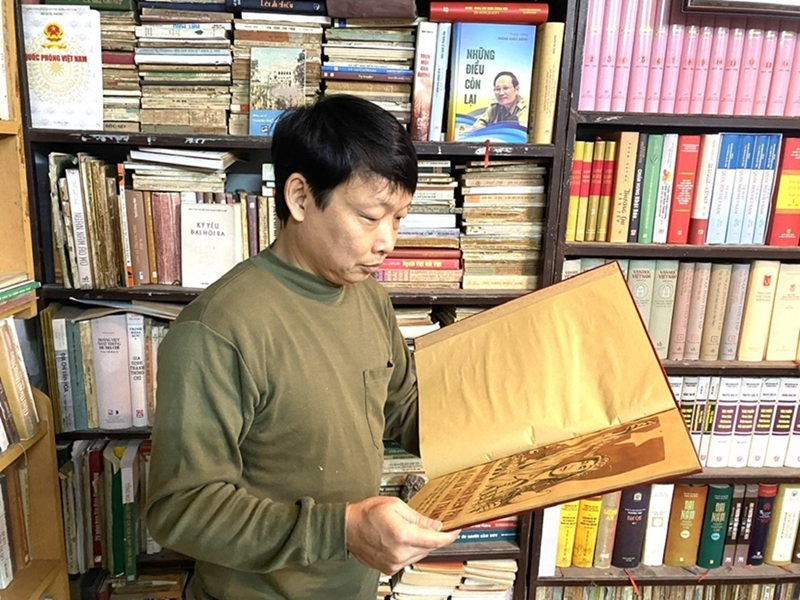Since late 1953, as preparations for the Dien Bien Phu Campaign progressed, the PAN was tasked with a special mission of producing newspapers directly in the war zone to serve as the “voice of the front,” reflecting combat activities, boosting troops’ morale, and recording the progress of our troops and people during a campaign whose success would determine the nation’s destiny.
The “field editorial office” was set up inside a small bunker at Pu Ma Hong (Muong Phang) on the eastern ridge of the battlefield. Equipment, including printing machines and a large supply of Lua Viet paper, do paper, and traditional handmade paper, was transported to the front using the simplest means. In conditions of extreme scarcity, danger, and constant bombardment, the journalists were determined to complete their mission.
    |
 |
|
Lawyer and press collector Ta Thu Phong reads copies of the 33 PAN’s issues published at Dien Bien Phu battlefield. |
The front editorial team had only five members, namely the team’s head Hoang Xuan Tuy, editor Tran Cu, illustrator artist Nguyen Bich, and two war correspondents Pham Phu Bang and Nguyen Khac Tiep.
On December 28, 1953, the first issue was printed on bamboo paper at Tham Pua Cave. At first, the paper was published every 4-5 days. Later, as the war intensified, publication increased to every three days, then every two days, and at times even daily. Because soldiers had little time to read, each issue had only two pages (except for the Lunar New Year (Tet) and special issues) with concise articles of 500-1,000 words written in clear, simple, and memorable language.
From the first issue (No.116, published on December 28, 1953) to the last (No.148, April 15, 1954), all 33 PAN’s issues were released regularly and delivered straight to the trenches for troops. They brought encouragement and unity. Short news pieces updated victories; editorials fueled morale; humorous stories and motivational sketches lifted spirits. All helped strengthen the resolve that ultimately led to victory.
The triumph at Dien Bien Phu battlefield was not only a clash of weapons and strategy but also a contest of will, faith, and spirit. The PAN’s issues at the front played a silent yet significant role by bringing the voice of the Party and President Ho Chi Minh to every trench, motivating troops to fight for victories.
The original 33 issues published at the front are currently preserved at the headquarters of the People’s Army Newspaper. They are historical evidence that capture the atmosphere, rhythm of life, and spirit of the Dien Bien Phu battlefield more authentically than any other documentation. From the perspective of the Law on Cultural Heritage, many experts, researchers, and the author of this article as well share the same view that these issues are not only important historical data, but also valuable documentary heritage, deserving to be recognized as national treasures, similar to other items in Vietnam’s national treasure system.
The key reasons are as follows: First, these issues were created under extraordinary conditions. They were published directly in the war zone. In 160 years of Vietnamese journalism, no other newspaper has achieved this. Produced with hand-operated printing machines and paper transported under fire and in shortage of materials and no electricity, they represent a heroic chapter written in ink, courage, wisdom and unwavering faith of frontline journalists. In the epic of victory, alongside feats-of-arms and sacrifice, stand these time-worn issues of the People’s Army Newspaper published at the front.
Second, they are the only complete, original set that exists today tied to the globally significant “globe-shaking” victory of Dien Bien Phu. They are not only ordinary journalistic products, but also living historical documents chronicling every stage of the campaign, from preparation and initial assaults to the final victory on May 7, 1954.
Third, distinct in creation and rare in publication, these issues are unique in their spiritual essence that each page embodies creative resilience, showcasing the wisdom and spirit of Vietnam in the most challenging conditions. They deserve national treasure status not only for their age or uniqueness but because they preserve the spirit of the Ho Chi Minh era where words, paper, and faith are intertwined amidst gunfire.
    |
 |
|
Delegates visit the display of the 33 issues in Dien Bien province, June 2025. |
Preserving and honoring them will help educate future generations about the vital frontline role of revolutionary journalism and the power of the press in the struggle for national salvation.
Today, all 33 issues are kept at the People’s Army Newspaper headquarters at 7 Phan Dinh Phung Street, Hoan Kiem ward, Hanoi as keepsakes of its fame. Recognizing them as national treasures would not only honor those who risked their lives to write history but also ensure special protection mechanism for this invaluable documentary heritage for generations to come, contributing to the preservation of national culture.
By Lawyer and press collector Ta Thu Phong
Translated by Mai Huong